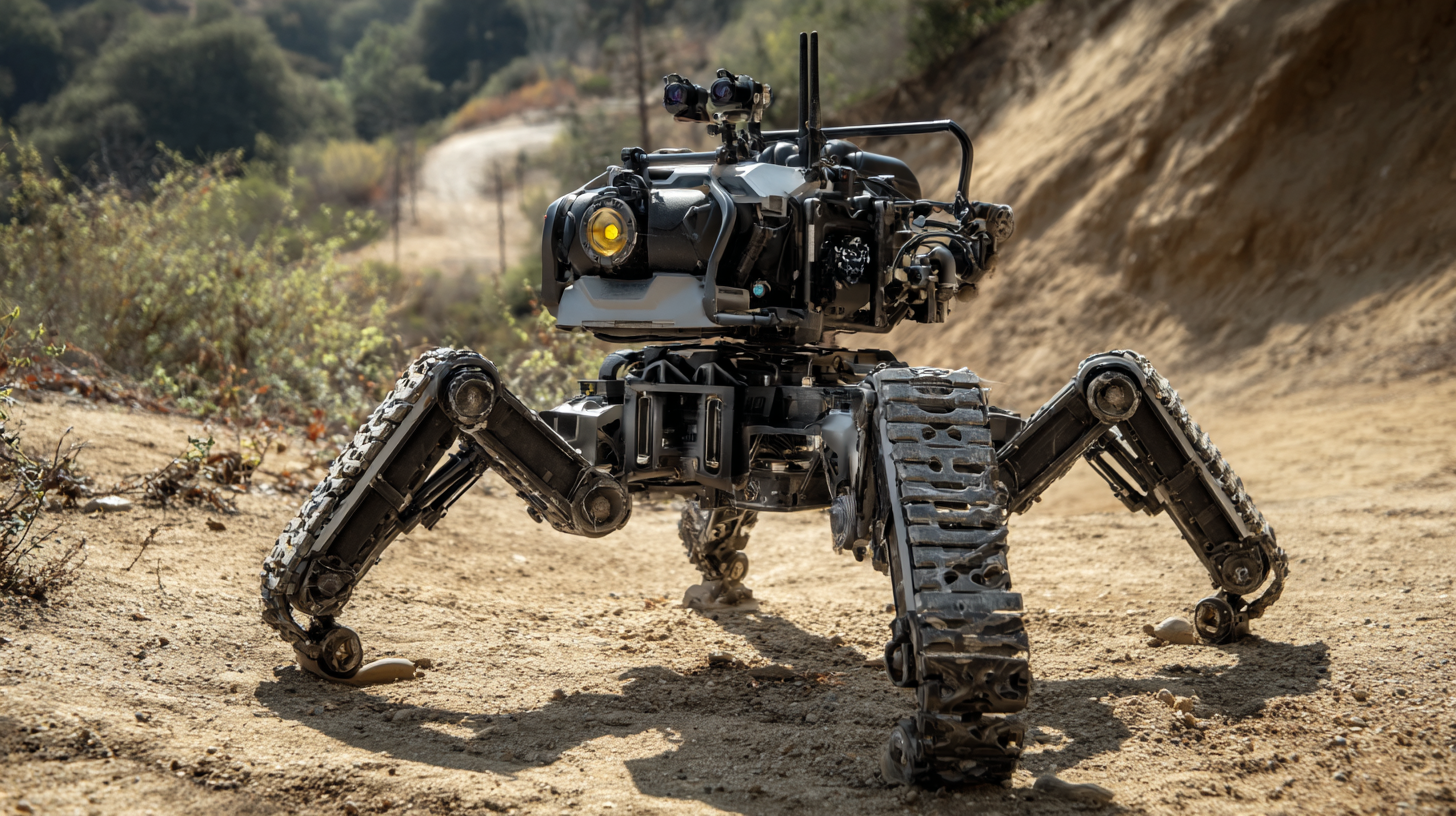In the realm of robotics, the design of walking robots has evolved significantly to address the challenges posed by diverse terrains. A prominent figure in this field, Dr. Emily Carter, a leading robotics engineer at Tech Innovations Lab, emphasizes the unique advantages of a "6 legged walking robot." She states, "The inherent stability and adaptability of a six-legged design enable these robots to navigate environments that are often impervious to wheeled or even bipedal counterparts."

The versatility of the 6 legged walking robot is paramount, particularly when traversing uneven surfaces such as rocky terrains, sandy beaches, or forested areas. With three pairs of limbs, these robots distribute their weight more evenly, allowing for a lower center of gravity and improved balance. This design not only enhances their capability to handle obstacles but also reduces the risk of tipping over, making them ideal for field applications ranging from search-and-rescue operations to environmental monitoring.
Furthermore, the ability to maneuver through complex landscapes while maintaining stability makes the 6 legged walking robot an invaluable asset in both commercial and research settings. As technology advances, the potential for these robots to offer solutions in previously challenging scenarios continues to grow, highlighting their critical role in the future of robotic navigation and exploration.
Six-legged robots have emerged as a formidable solution for navigating challenging terrains, particularly in environments where stability is paramount. According to a report by RoBERT, the adaptability of hexapod robots allows them to maintain balance across uneven ground, with a remarkable foot placement strategy that minimizes the risk of tipping over. This capability is particularly essential in scenarios such as search-and-rescue operations in disaster-stricken areas, where the terrain may be unpredictable and hazardous. The report illustrates that hexapods can traverse slopes of up to 45 degrees and manage obstacles as high as 30% of their own height, proving their unparalleled versatility.
Moreover, the inherent design of six-legged robots significantly enhances their locomotion efficiency. Research published in the International Journal of Robotics Research highlights that these robots can achieve superior gait patterns, allowing for energy-efficient movement across diverse surfaces, from rocky paths to sand. The advanced algorithms used in their locomotion mechanics afford them the ability to adapt their walking patterns in real-time, ensuring optimal navigation in rough conditions. With data suggesting that six-legged robots can maintain mobility even when 50% of their legs are compromised, they stand out as a robust choice for operations in extreme environments, driving advancements in robotics technology and paving the way for their increased deployment in various fields.

The design of a 6-legged walking robot incorporates several key features that significantly enhance its stability, particularly when navigating diverse terrains. One of the most crucial elements is the use of a distributed weight system. By evenly spreading the robot's weight across six points of contact, it minimizes the risk of tipping and allows for better balance compared to traditional 4-legged robots. This configuration also grants the robot a lower center of gravity, which is vital when traversing uneven ground or steep inclines.
Additionally, advanced sensors and adaptive control algorithms play a pivotal role in maintaining stability. These robots are equipped with gyroscopes and accelerometers that constantly monitor their orientation and movement. The real-time data collected enables the robot to make instantaneous adjustments to its gait and posture, responding dynamically to changes in the terrain. Combining active motion control with a flexible leg design allows the robot to maintain a steady stance, whether ascending stairs or maneuvering over obstacles. This enhanced adaptability makes 6-legged walking robots not only stable but also highly versatile for various applications in challenging environments.
| Feature | Description | Benefit |
|---|---|---|
| Multi-Legged Actuation | Utilizes six legs with independent movement | Improves adaptability to uneven terrain |
| Gait Optimization Algorithms | Incorporates advanced algorithms for leg movement | Increases efficiency and reduces energy consumption |
| Real-Time Terrain Analysis | Equipped with sensors to analyze ground conditions | Enhances navigation capabilities in diverse environments |
| Adaptive Suspension System | Features a dynamic suspension mechanism | Maintains stability over obstacles and rough terrain |
| Distributed Weight Management | Design that evenly distributes the robot's weight | Prevents tipping and enhances overall stability |
When comparing the capabilities of 6-legged walking robots to traditional designs such as wheeled or tracked robots, the advantages of enhanced stability and adaptability become clear. According to the International Journal of Robotics Research, 6-legged robots can maintain stability on uneven terrain due to their ability to control multiple limbs simultaneously. This multimodal locomotion enables them to navigate complex environments with greater ease than their two-legged or wheeled counterparts, which often struggle on rough surfaces.
A study published by the IEEE Robotics and Automation Magazine highlights that 6-legged robots are particularly effective in navigating environments characterized by obstacles and varying elevations. These robots can distribute their weight more evenly and adapt their posture dynamically, allowing for improved traction and balance. The research indicates that when traversing rocky or steep terrains, 6-legged robots exhibit up to a 30% increase in stability compared to traditional wheeled robots.
This adaptability not only broadens their application in fields like search and rescue or planetary exploration, but also underscores their potential in industrial settings where terrain variability can pose significant challenges.
6-legged walking robots have emerged as a game-changing technology across diverse sectors, offering unparalleled stability and adaptability for navigating complex terrains. These robots are particularly advantageous in environments that pose challenges for traditional wheeled or tracked vehicles. For instance, recent studies from the International Journal of Robotics Research report that 6-legged robots are capable of maintaining balance on uneven surfaces, reducing the risk of tipping by up to 40% compared to 4-legged counterparts. This stability makes them ideal for applications in search and rescue operations, where uneven terrain is a significant barrier.
In agriculture, 6-legged robots are transforming the way tasks are performed. According to the Agricultural Robotics Industry Report, the global market for agricultural robots is projected to reach $11.7 billion by 2025. These robots can traverse fields with various obstacles, performing tasks such as planting, monitoring crops, and even harvesting, all while minimizing soil compaction. Their ability to adapt to varied terrain enhances operational efficiency and reduces labor costs significantly.
Tips: When considering the implementation of a 6-legged robot, assess the specific terrain challenges you face and the robot’s payload capabilities. Additionally, keep in mind that integrating AI for navigation can substantially improve performance in dynamic environments. Lastly, regular maintenance ensures longevity, allowing you to leverage these advanced machines for extended periods.

When optimizing a six-legged robot for varied terrains, several critical factors come into play. First, the design of the legs should incorporate a combination of versatility and strength. Each leg must be capable of independent movement, allowing the robot to adapt to uneven surfaces. Agile joints can enhance the robot's ability to maneuver over obstacles such as rocks and logs, while robust materials can ensure durability against harsh environmental conditions.
Another essential element to consider is the robot's control system. Implementing advanced algorithms for gait adaptation is crucial. These algorithms should analyze terrain feedback in real-time, enabling the robot to adjust its walking pattern for optimal stability. Additionally, incorporating sensors that detect changes in the ground surface can significantly improve navigation efficiency. This responsiveness not only enhances performance on varied terrain but also prevents potential falls, ensuring the robot remains upright and stable during its operations.
This chart illustrates the performance metrics of 6-legged walking robots across different terrains, showcasing their stability and navigation efficiency.






